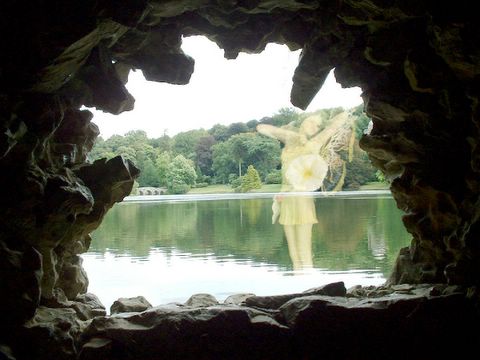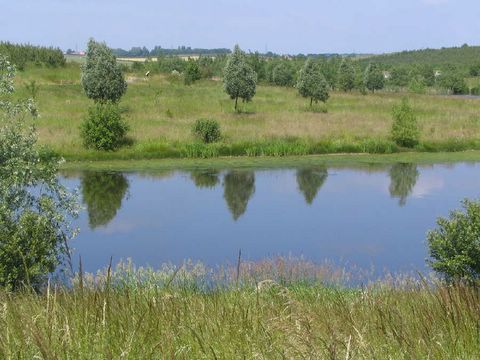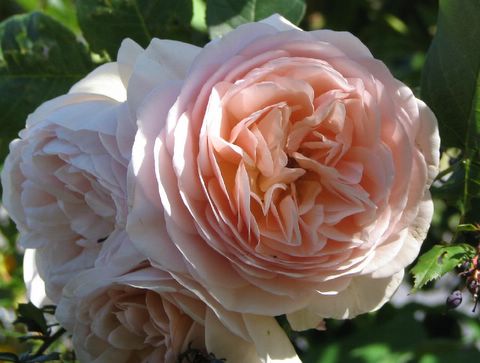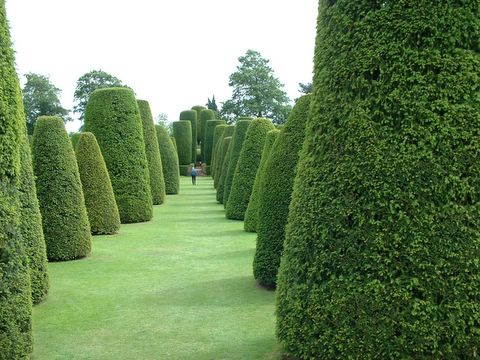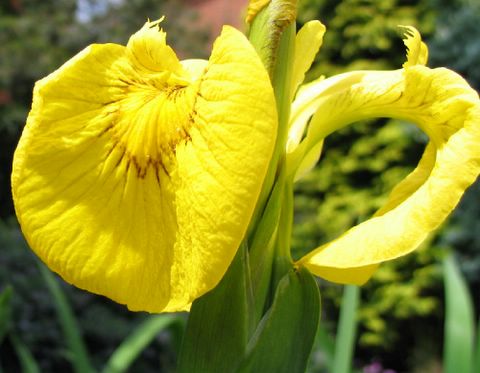On one of our trips to London to visit our daughter we took the opportunity to take a look at Syon Park, home to the Duke of Northumberland for over four hundred years and still owned and looked after by them. Situated across the Thames from Kew Gardens it has a very lovely setting, although the approach through Brentford is not the most attractive. The house from the outside is rather austere almost fortress looking, and was originally the site of a late medieval Abbey. It has Tudor origins and contains some of Robert Adam's finest interiors, which were commissioned by the first Duke of Northumberland in the 1760s. Syon House, a three-storied structure of brick with some ashlar facings, square angle-turrets, and flat, lead-covered roofs surmounted by battlements, is built round a central, open courtyard about 80 feet square, and stands at an oblique angle to the Thames on the north of the village of Isleworth. Described in the 19th century as 'one of the most conspicuous ornaments of the county of Middlesex' and in the 20th as able to 'hold its own with the lesser palaces of the Continent'. Syon came into the possession of Henry Percy, 9th Earl of Northumberland on his marriage in 1594, and is the last of the great country houses in the environs of London to remain in the occupation of its ancestral owners.
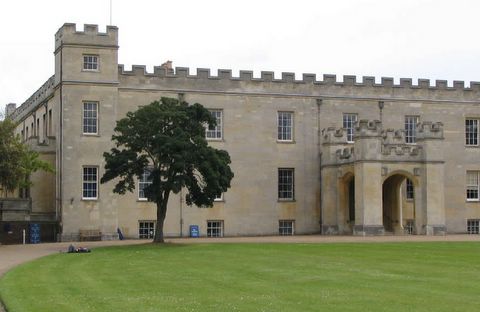
Syon House

We took the audio tour of the house which was, I thought, good value although how much of the information I was able to absorb is open to debate. I am usually reluctant to buy the guide books on offer at these places because you tend to spend so much time reading that you almost forget to look at what you are reading about. And, if you are anything like me, you will instantly forget it all. As usual, photography is not allowed inside the house, but there are some reasonable pictures on their web site which I have borrowed the purposes of this piece. All the exterior pictures are my own, and for which I take the full blame.
The tour starts in the Great Hall which is certainly impressive, being based on a Roman Basilica and whose purpose as designed by Adam was to provide an impressive entrance for all the Duke’s guests. This is still the case today, even if many of the guests are just the general public paying for the privilege. The decorative stucco work throughout the house was all the work of Joseph Rose who was often employed by Adam in many of the great houses of England; in this room the black and white of the floor being replicated on the ceiling.

Great Hall

_____________________________________________________________
The ante-room, by contrast, is the most richly coloured of Adam's rooms which survive, with verd-antique columns, gilt Ionic capitals and statuettes, an entablature with a honeysuckle frieze on a blue ground, gilded trophies on the walls, and the whole reflected in a polished scagliola floor, one of the earliest uses of the material in England. The anteroom is actually 30 feet wide by 36 feet long, but by standing the columns away from the south wall Adam created the effect of a square room. He heightened the state rooms along the south wing, but retained their other proportions.

Ante Room

_____________________________________________________________
The diningroom, finished in stucco and adorned with statues in place of damask or tapestry that it might 'not retain the smell of the victuals', is some 66 feet long but only 21 feet high and wide; for picturesqueness, he placed apses at each end, with ornamented halfdomes and screens of columns, and whilst white and gold predominate in the dining-room, the deep colouring of the statue niches was not part of Adam's plan.

State Dining Room

_____________________________________________________________
The red drawing-room is a profusion of rich colour, with plum-red Spitalfields silk damask on the walls, a specially designed carpet executed by Thomas Moore of Moorfields in 1769 on the floor, and an elaborate ceiling with wooden medallions painted by Cipriani. This replaced the original plan for a simpler ceiling in white and gold to match the pattern of the carpet, as so many of Adam's ceilings match the floors. The fireplace of this room was made to Adam's designs by Matthew Boulton; both this and the ivory pilasters of the Spanish mahogany doorcases are decorated in ormolu. The doors of all the rooms on the south wing's principal floor are so placed that a vista of the entire front may be obtained when they are open. Behind the State rooms are the private apartments which overlook the central courtyard. These rooms are still used when the family is in residence so that they can keep apart from the visitors to the house.

Red Drawing Room

_____________________________________________________________
Once a bedchamber in the 18th century, it has more recently been used as a family sitting room. This room is adorned with 17th century Dutch paintings collected by the 1st Duchess and 18th century porcelain. The attractive marble fireplace, with its carved plaque representing Aesop’s Fable of the Fox and the Stork was brought from Northumberland House, (the Percy family’s principal London residence, which was demolished in 1874). The two 18th century armchairs in front of it have tapestry covers stitched by Helen, 8th Duchess and her sister in the 1930s.

Duchess Sitting Room

_____________________________________________________________
In the long gallery Adam contented himself with a masterly redecoration which has been acclaimed his greatest work; he described it as 'finished in a style to afford great variety and amusement'. The ceiling is set out with circles down its length of 136 feet; each circle is held in an octagonal framework separated from the next by a square. Horizontal unity is achieved by cross-lines which tend to expand the apparent width of a room which is in fact no more than 14 feet wide and high; vertical unity is given by a series of 62 pilasters painted by Pergolesi. Secret closets open from the gallery at either end.
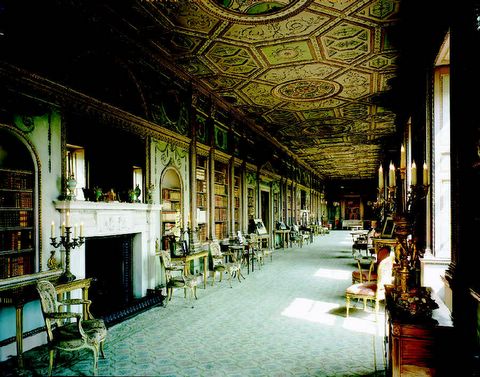
Long Gallery

_____________________________________________________________
The interior of the house is matched in its grandeur by the grounds and gardens which have been renowned for their extensive collection of rare trees and plants since 'Capability' Brown landscaped the park in the mid 18th century. Within the 200 acres of parkland designed by Lancelot 'Capability' Brown from the 1750s to 1770s, there are 40 acres of gardens and an ornamental lake. These gardens are renowned for their extensive collection of 200 species of rare trees.
The crowning glory of Syon Park's gardens is the Great Conservatory. The 3rd Duke of Northumberland commissioned Charles Fowler to build a new conservatory in 1826, the first of its kind to be built out of gunmetal, Bath stone and glass.
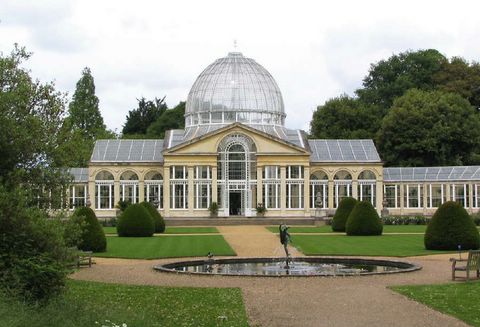
Great Conservatory

It was originally designed to act as a show house for the Duke's exotic plants and inspired Joseph Paxton in his designs for the Crystal Palace.

Great Conservatory Walkway

The inside of the dome is very impressive and gives a much greater impression of its size than from the outside.

Great Conservatory Dome

Also living inside the Conservatory was this peacock showing off his magnificent tail. Quite how these creatures manage to fly is beyond me, but obviously they can, as there was no other way up there. He was also creating the most deafening noise as he called to his mate somewhere on the other side. We had seen her earlier by the restaurant begging for food. She seemed to have different priorities to him!

Great Conservatory Peacock

The object of his desire!

Peahen

_____________________________________________________________
This towering ornament in the gardens was created c.1758 when the 1st Duke of Northumberland converted a large orchard into the 'Syon Pleasure Ground'. Flora stands on a 55 foot (16.7m) column and overlooks a lawn named after her that has organically grown herbaceous beds containing ornamental thistles, Euphorbias, Pholox, Scabious, Gypsophilia and great clumps of Prince of Wales plants. Not sure if the bird on her head adds any dignity!

Flora

The other principal feature of the pleasure ground is the lake which is a haven for wildlife including terrapins, although we didn’t see any.

The Lake

Also there are many flower beds and borders, which will look better later in the season I think.
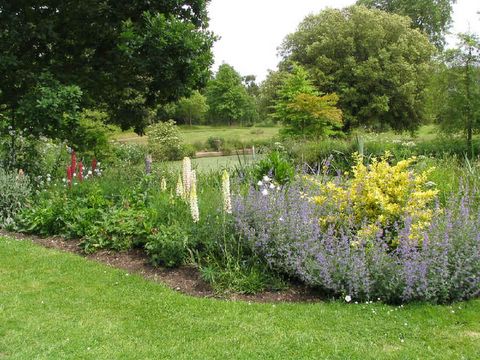
Borders

One thing that Adam or Capability Brown could never have imagined, was the constant roar of planes coming into Heathrow, just a few mile s up the road. It certainly didn’t do much for the tranquillity that you might otherwise have expected from the beautiful gardens.

Plane

Numerous television historical dramas, Byron, The Lost Prince, The Young Visiters, Longitude, Looking for Victoria, Daniel Deronda, Agatha Christie's - Poirot, Wives and Daughters, Love in a Cold Climate, to name but a few have been set here.. Syon House is widely featured in the Robert Altman feature film Gosford Park and has also appeared in The Madness of King George, The Wings of the Dove, Emma, The Golden Bowl and The Avengers
For more information take a look at
Syon Park: The London home of the Duke of Northumberland
